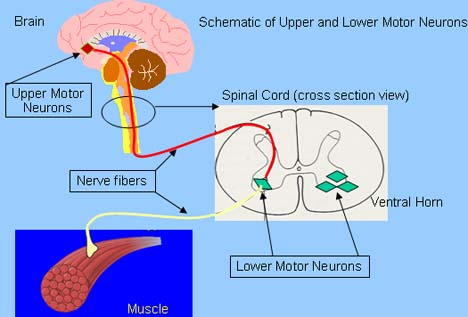ALS, or amyotrophic lateral sclerosis, is a disease that has received much attention in the past few months due to the infamous “Ice Bucket Challenge.” Though this blog is not a blog about said challenge, it is a blog about the debilitating disease- because, let’s be honest; you all probably know what the Ice Bucket Challenge is and maybe have even taken it, but do you know what ALS actually is? Until this past week, even I jumped on the popular social media bandwagon of the IBC but did not understand the complexities of the science and real-life impact of ALS.
ALS is marked by degeneration of motor neurons of the central nervous system. This means that as ALS progresses, it becomes harder and harder for the body’s muscles to be completely controlled. Thus some symptoms of ALS include muscle weakness, muscle atrophy (degeneration), and eventually paralysis. ALS is also fatal and progresses quickly to this end.

The above picture shows the path of a nerve from the brain to a muscle. The lower motor neurons are the ones affected by ALS.
This past week in Concordia’s Neurochemistry class, we read a paper discussing the science behind and players in the development of ALS in the body. Though ALS can be passed down in families, most of the disease happens by random chance. Contributing factors to the disease include: mutations in genes that cause some proteins to stop working correctly (particularly the SOD1 enzyme), too high of levels of glutamate (a key neurotransmitter in the body), improperly working cell-receptors that respond to glutamate, and many other failings of cellular systems in neurons. All of these factors lead to the ultimate death of the motor neurons.
The key message of the science of this article was that more factors then first thought contribute to ALS development. One thing going wrong doesn’t necessarily cause ALS, there are many players contributing to this field. The article focused on one specific receptor called an NMDA receptor that was previously not thought to be involved in ALS. This receptor may be more involved than scientists thought. All this goes to show that there may be more at play in complex disease than it seems at first, and one clear answer of what is going wrong may not be present.
ALS and its causes are complex. An eventual cure will probably be even more complex. Though awareness is a good thing, it will take much more than hashtagging and being cold for a few seconds to cure the complexities of ALS, but as scientists continue to research this disease, we can hope that they will find treatments that may eventually help ALS patients.
References:
The article I mention is from: http://www.sciencedirect.com/science/article/pii/S0925443912002736
The picture is from: http://web.alsa.org/site/PageServer?pagename=ALSA_Disease_Process_ALS